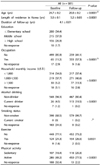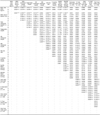1. Statistics Korea. Survey of foreign residents in Korea [Internet]. Seoul: Ministry of Security and Public Administration;2014. cited 2015 August 13. Available from:
http://kostat.go.kr.
2. Yang EJ, Chung HK, Kim WY, Bianchi L, Song WO. Chronic diseases and dietary changes in relation to Korean Americans' length of residence in the United States. J Am Diet Assoc. 2007; 107:942–950.

3. Kim YP, Kim S, Joh JY. Family adaptability and cohesion in families consisting of Asian immigrant women living in South Korea: a 3-year longitudinal study. Asia-Pac Psychiatry. 2015; 7:206–214.

4. Berry JW. Immigration, acculturation, and adaptation. Appl Psychol. 1997; 46:5–34.

5. Chae SM, Park JW, Kang HS. Relationships of acculturative stress, depression, and social support to health-related quality of life in Vietnamese immigrant women in South Korea. J Transcult Nurs. 2014; 25:137–144.

6. Tseng M, Fang CY. Stress is associated with unfavorable patterns of dietary intake among female chinese immigrants. Ann Behav Med. 2011; 41:324–332.

7. Hwang JY, Lee SE, Kim SH, Chung HW, Kim WY. Psychological distress is associated with inadequate dietary intake in Vietnamese marriage immigrant women in Korea. J Am Diet Assoc. 2010; 110:779–785.

8. Regev-Tobias H, Reifen R, Endevelt R, Havkin O, Cohen E, Stern G, Stark A. Dietary acculturation and increasing rates of obesity in Ethiopian women living in Israel. Nutrition. 2012; 28:30–34.

9. Kwok S, Mann L, Wong K, Blum I. Dietary habits and health beliefs of Chinese Canadians. Can J Diet Pract Res. 2009; 70:73–80.
10. Tserendejid Z, Hwang J, Lee J, Park H. The consumption of more vegetables and less meat is associated with higher levels of acculturation among Mongolians in South Korea. Nutr Res. 2013; 33:1019–1025.

11. Rosenmöller DL, Gasevic D, Seidell J, Lear SA. Determinants of changes in dietary patterns among Chinese immigrants: a cross-sectional analysis. Int J Behav Nutr Phys Act. 2011; 8:42.

12. Nguyen PH, Strizich G, Lowe A, Nguyen H, Pham H, Truong TV, Nguyen S, Martorell R, Ramakrishnan U. Food consumption patterns and associated factors among Vietnamese women of reproductive age. Nutr J. 2013; 12:126.

13. Wu J, Xu G, Shen L, Zhang Y, Song L, Yang S, Yang H, Yuan J, Liang Y, Wang Y, Wu T. Parity and risk of metabolic syndrome among Chinese women. J Womens Health (Larchmt). 2015; 24:602–607.

14. Edyta S, Dorota K, Elzbieta C, Stanislaw G. Association between dietary patterns and metabolic syndrome in individuals with normal weight: a cross-sectional study. Nutr J. 2015; 14:1–10.

15. Hwang JY, Lee H, Ko A, Han CJ, Chung HW, Chang N. Dietary changes in Vietnamese marriage immigrant women: the KoGES follow-up study. Nutr Res Pract. 2014; 8:319–326.

16. Lyu JE, Yang YJ, Lee SE, Chung HW, Kim MK, Kim WY. Nutritional status of Vietnamese female marriage immigrants to Korea in relation to length of residence in Korea. Ann Nutr Metab. 2009; 55:317–324.

17. Kim SH, Kim WY, Lyu JE, Chung HW, Hwang JY. Dietary intakes and eating behaviors of Vietnamese female immigrants to Korea through marriage and Korean spouses and correlations of their diets. Korean J Community Nutr. 2009; 14:22–30.
18. Friedewald WT, Levy RI, Fredrickson DS. Estimation of the concentration of low-density lipoprotein cholesterol in plasma, without use of the preparative ultracentrifuge. Clin Chem. 1972; 18:499–502.

19. The Korean Nutrition Society. Nutritional assessment program, 'Can-pro 3.0' [CD-ROM]. Seoul: The Korean Nutrition Society;2006.
20. Neuhouser ML, Thompson B, Coronado GD, Solomon CC. Higher fat intake and lower fruit and vegetables intakes are associated with greater acculturation among Mexicans living in Washington State. J Am Diet Assoc. 2004; 104:51–57.

21. Batis C, Hernandez-Barrera L, Barquera S, Rivera JA, Popkin BM. Food acculturation drives dietary differences among Mexicans, Mexican Americans, and Non-Hispanic Whites. J Nutr. 2011; 141:1898–1906.

22. Lv N, Cason KL. Dietary pattern change and acculturation of Chinese Americans in Pennsylvania. J Am Diet Assoc. 2004; 104:771–778.

23. Satia JA, Patterson RE, Kristal AR, Hislop TG, Yasui Y, Taylor VM. Development of scales to measure dietary acculturation among Chinese-Americans and Chinese-Canadians. J Am Diet Assoc. 2001; 101:548–553.

24. Mohan V. Why are Indians more prone to diabetes? J Assoc Physicians India. 2004; 52:468–474.
25. Lee WP, Lingard J, Bermingham M. Change in diet and body mass index in Taiwanese women with length of residence in Australia. Asia Pac J Clin Nutr. 2007; 16:56–65.
26. Yang SJ, Choi HY, Chee YK, Kim JA. Prevalence and correlates of obesity and overweight among Asian immigrant women in Korea. Asia Pac J Public Health. 2012; 24:620–630.

27. Azadbakht L, Esmaillzadeh A. Red meat intake is associated with metabolic syndrome and the plasma C-reactive protein concentration in women. J Nutr. 2009; 139:335–339.

28. Connor WE, Cerqueira MT, Connor RW, Wallace RB, Malinow MR, Casdorph HR. The plasma lipids, lipoproteins, and diet of the Tarahumara indians of Mexico. Am J Clin Nutr. 1978; 31:1131–1142.

29. Hong S, Song Y, Lee KH, Lee HS, Lee M, Jee SH, Joung H. A fruit and dairy dietary pattern is associated with a reduced risk of metabolic syndrome. Metabolism. 2012; 61:883–890.

30. Ministry of Health and Welfare, Korea Centers for Disease Control and Prevention. Korea Health Statistics 2013: Korea National Health and Nutrition Examination Survey (KNHANES VI-1). Cheongju: Korea Centers for Disease Control and Prevention;2014.
31. Khan NC, Hoan PV. Vietnam recommended dietary allowances 2007. Asia Pac J Clin Nutr. 2008; 17:Suppl 2. 409–415.








 PDF
PDF ePub
ePub Citation
Citation Print
Print


 XML Download
XML Download